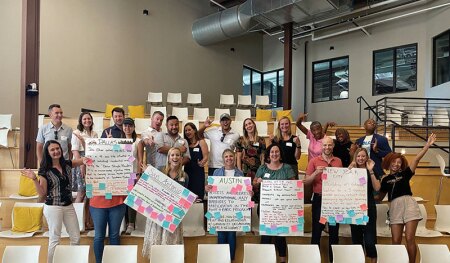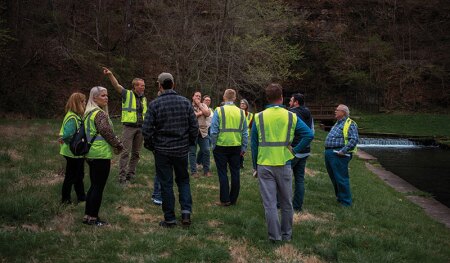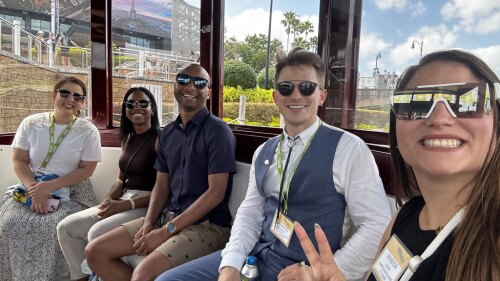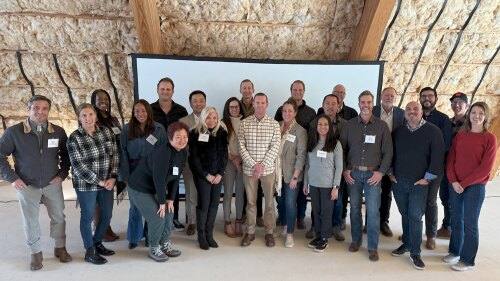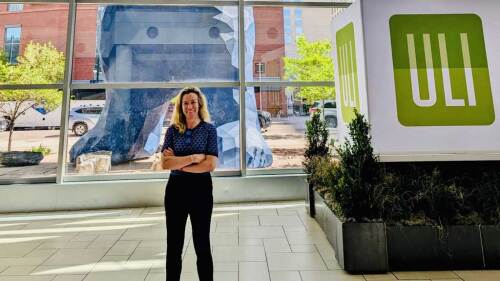Foundations have given over $10 million to bolster the Institute’s efforts to help communities across the United States.
In northwest Arkansas, the town of Cave Springs started out more than a century ago as a stop along the old Kansas City and Memphis Railway. It has a cozy downtown of historic buildings with antique shops and restaurants and lush green space all around, and offers easy commuting access to jobs in nearby Bentonville. As a result, its population has tripled over the past decade to about 5,500, making it the fastest-growing city in the state, according to Wes Craiglow, executive director of ULI Northwest Arkansas.
But the growth of Cave Springs and other small cities in the region has challenged local governments that have to handle planning and zoning. However, ULI Northwest Arkansas, which is assisting by providing technical expertise, has an important benefactor to turn to for support. “We approached the Walton Family Foundation and said, ‘We’ve got this concept,’” Craiglow says.
Thanks to the foundation’s commitment to fostering inclusive growth and access to employment centers, services, and amenities, “we are able to advance best practices in land use management and city planning for these places, through our technical assistance panels,” he says.
Ultimately, with the help of the Walton Family Foundation’s backing, ULI will be able to partner with the small cities to develop requests for proposals (RFPs) and work with a nationally prominent planning firm to create the documents they need to manage their growth.
That is just one of the recent ULI efforts that have been made possible by major philanthropic institutions’ generosity. While individual donors have been a powerful driver behind the ULI Foundation’s Our Cities, Our Future campaign, which aims to raise $100 million to tackle the world’s most pressing land use challenges, five prominent foundations also have played a vital role.
Along with the Walton Family Foundation, benefactors such as The JPB Foundation, the JPMorgan Chase Foundation, the Kresge Foundation, and the Robert Wood Johnson Foundation cumulatively have contributed more than $10 million to support various ULI programs.
Their willingness to support the Institute’s mission has made possible the launch of important initiatives in areas ranging from climate resilience and decarbonization to increasing the supply of housing and improving diversity and equity across the real estate industry.
For the institutions, these contributions are a way of leveraging the Institute’s national and international network of experts in various fields and local connections, and in the process optimizing the impact of their philanthropic dollars. ULI is proud to center social and racial justice considerations in each project.
Here are descriptions of the five foundations’ giving, and the impact of that generosity through the ULI programs they have supported.
The JPB Foundation
The JPB Foundation directs its giving to three program areas: “promoting opportunities for people in poverty, advancing medical research, and enabling a healthy environment.”
The JPB Foundation giving to ULI to date has focused on increasing equitable access to parks and green space and enhancing climate resilience in communities, with a particular focus on low-income and disinvested places.
The foundation’s support has helped ULI deliver technical assistance in 16 communities under the current grant, according to Rachel MacCleery, co–executive director of ULI’s Randall Lewis Center for Sustainability in Real Estate. In Philadelphia, for example, a ULI panel heard about community concerns, hopes, and dreams for West Fairmount Park, a vast and under-resourced park in a disadvantaged part of the city, and put together recommendations on how to center the community in decision-making and leverage revenues to fund improvements.
Another panel in Denver provided advice on reimagining an urban boulevard to make it more accessible for multimodal transportation, while providing recreational opportunities along the route. In Meridian, Idaho, a panel provided recommendations for implementing an equitable, sustainable, and accessible trail and pathway system across the rapidly growing city.
The Robert Wood Johnson Foundation
The Robert Wood Johnson Foundation describes its mission as “building a culture of health for America.” The foundation has contributed over $4 million to ULI so far, providing funding for work that focuses on intersections among real estate, the built environment, and health and racial equity.
The foundation has been a key funder of the District Council Partnerships for Health Equity program, an effort by five ULI district councils to highlight the effects of racially discriminatory land use and transportation policies on the health of marginalized local residents.
In Toronto, for instance, ULI Toronto launched an effort to track the historical displacement of Black residents in Toronto neighborhoods, and identify action steps to begin to address the impacts of this displacement. In St. Louis, the ULI district council has lifted up the need for more resources for the repair and restoration of existing homes, and is spearheading the creation of a new network to better coordinate home repair efforts in the city.
The foundation was also the key funder of the seminal 2022 ULI report, 10 Principles for Embedding Racial Equity in Real Estate Development. “The report summarizes 10 guiding ideas that can help developers, investors, and other practitioners make racial equity a central part of their real estate practice and deliver benefits for communities,” says MacCleery, who notes that it is one of the most widely read reports on the Institute’s Knowledge Finder website.
The foundation has supported the research and writing of other recent ULI reports, including Reshaping the City: Zoning for a More Equitable, Sustainable, and Resilient Future, which was also supported by The JPB Foundation, and an upcoming ULI report on the issue of climate gentrification, in which demographic shifts driven by climate change threaten to displace existing residents of communities.
The JPMorgan Chase Foundation
The philanthropic arm of the nation’s biggest bank has been a significant ULI supporter, providing $1 million toward helping communities grappling with the issues of climate resilience. One of the major efforts this foundation backs is the New Resilient Land Use Cohort, a project that supports local government and community groups to improve climate resilience, with a focus on historically marginalized groups, who are often more affected by climate change.
“We have worked with over 12 different municipalities and local sponsors to address everything from extreme heat and flooding, to resilience hubs and green infrastructure” as a result of JPMorgan’s gifts, explains Lindsay Brugger, a ULI vice president and leader of the Urban Resilience program. “We’ve done some post-tornado work as well as a lot of work at the intersection of equity and climate resilience.”
In New York City, for example, a ULI technical assistance panel worked with the city’s housing authority to evaluate one of its properties for climate risks, including extreme heat and flooding. After the panel, “We were able to help them with the creation of a ‘look book’ for cloudburst infrastructure, which addresses heavy rainstorms,” says Brugger. “They actually referenced it in an RFP that they put out, so that the proposals they accept and implement are referencing the best practices that ULI created. NYCHA [New York City Housing Authority] provides housing for 400,000 people, so it’s essentially like helping a small city.
“Our resilient land use cohort is explicitly working with community-based organizations,” in places such as the Lower Ninth Ward in New Orleans and the Eastwick community in Philadelphia, Brugger says. That involvement “ensures that these local solutions and local challenges are addressed in a way that benefits everybody.”
The Kresge Foundation
The Kresge Foundation, started in 1924 by department store chain founder Sebastian Spering Kresge, has concentrated its philanthropic efforts in recent years, expanding opportunities in American cities and helping create pathways for people with low incomes and improving their life circumstances. It has given over $1.1 million to support the Our Cities, Our Future campaign and, as with JPMorgan Chase, has included a focus on helping marginalized communities’ climate preparedness.
A recent Kresge Foundation grant aims at improving urban resilience against extreme weather linked to climate change such as heat waves, drought, storms, and floods, as well as reducing energy use and carbon emissions in buildings, all while prioritizing economic growth and centering racial equity in low-income and BIPOC and minority communities.
One part of the project involves examining how to support and expand the impact of a local coalition of organizations that provide home weatherization assistance in low-income communities of color in St. Louis. It also includes efforts to enhance equitable development in Dallas by addressing climate issues, and advancing climate resilience, racial equity, and economic development with a local community group in the Ninth Ward of New Orleans.
Past contributions have funded an extreme heat resilience roundtable in Nashville, Tennessee, and an Advisory Services panel in San Jose, California, on how to incentivize the adoption of on-site solar and battery storage of energy, with an eye toward controlling low-income residents’ housing costs as buildings convert to electricity and clean energy.
“Thanks to our grant from the Kresge Foundation, ULI’s Just, Green, and Ready Communities program is able to sharpen our focus on supporting ULI district councils and their local community partners who are already working on issues of racial equity within the climate conversation,” explains Marta Schantz, co–executive director of the ULI Randall Lewis Center.
“Our goal is to collectively pursue projects that use the potential of investments in climate resilience and decarbonization to drive economic growth for low-income communities and communities of color, who have typically been excluded from those opportunities. That’s been a key priority of environmental and climate justice advocates for a long time, and we’re excited to follow that directive in this program,” Schantz adds.
The Walton Family Foundation
The Walton Family Foundation states as its mission: “strengthening the connections between K–12 education and lifelong opportunity; protecting rivers, oceans, and the communities they support; and advancing our home region of Northwest Arkansas and the Arkansas-Mississippi Delta.” The foundation has donated more than $2,8 million to the Our Cities, Our Future campaign, with a particular focus on bringing development and support to cities.
The foundation’s support for the Institute is helping Cave Springs develop a blueprint for its future. Funding enabled a panel of ULI experts to tour the city’s downtown, conduct interviews with local stakeholders, and gather information that will be part of an upcoming report.
“This has been a positive experience that will benefit our city for years to come,” says Randall Noblett, mayor of Cave Springs. “I would recommend the program to anyone who has the opportunity in the future. I want to thank the ULI group and the Walton Family Foundation for making this all possible.”
Once the city eventually creates a master plan with the Institute’s assistance, the planning will ensure that the traditional downtown of Cave Springs is preserved.
“That cute little hardware store and the coffee shop and the historic buildings, the old city hall in the middle—all that becomes the living room of that community, and a character feature of that city for generations to come,” Craiglow says.
That type of planning groundwork will benefit the new residents who are flocking to the region, says Craiglow, who points out that more than half of the housing starts there are not in big cities, but smaller bedroom communities. “We want to help the small cities to help themselves,” he explains. And thanks to the Walton Family Foundation’s support, ULI is able to achieve that objective
“Our supporters have expressed their eagerness to collaborate with us as they discover the extensive reach and influence of ULI and its members,” said Janice Periquet, president of the ULI Foundation. “They recognize that by connecting with the real estate community, they can effectively pursue and attain their own goals.”
PATRICK J. KIGER is a Washington, D.C.–based journalist.

